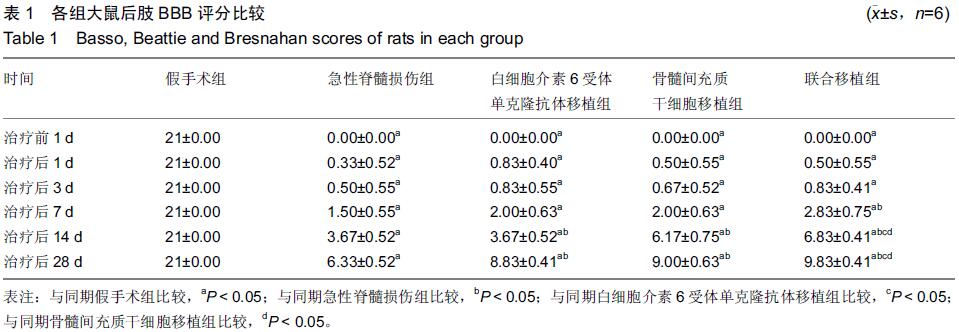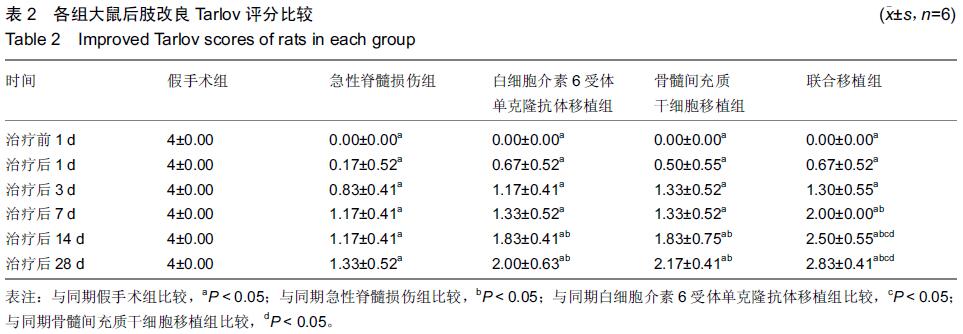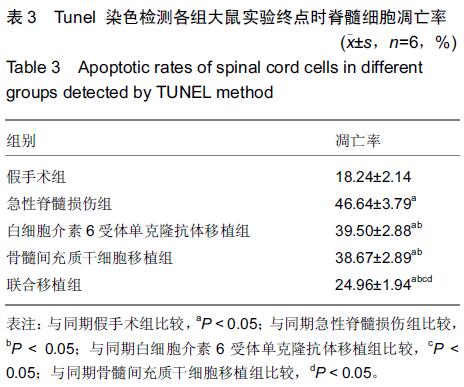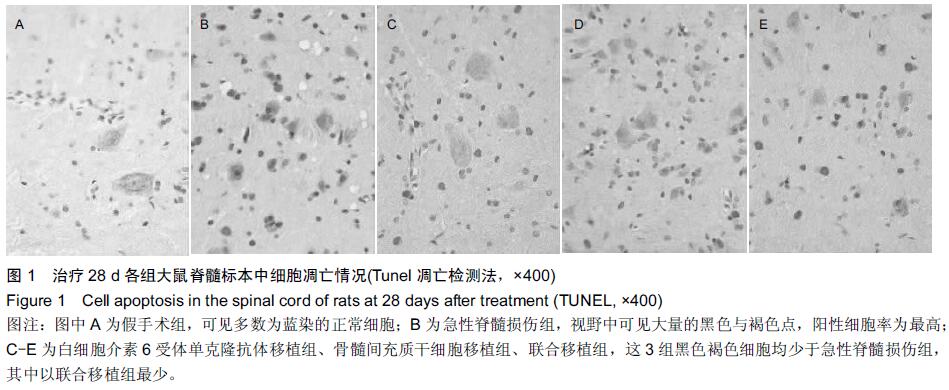| [1] 李盛华,张绍文,樊成虎.1005例胸腰椎骨折住院患者流行病学特征分析[J].西部中医药,2014, 7(5):70-73. [2] Yip PK, Malaspina A. Spinal cord trauma and the molecular point of no return. Mol Neurodegener. 2012; 7:6. [3] 郑力恒,林宏生,李锦聪,等.脊髓损伤后急性期甲基强的松龙干预对脊髓神经细胞凋亡的影响[J].中国脊柱脊髓杂志, 2012, 22(5):452-458. [4] Cafferty WB, Gardiner NJ, Das P, et al. Conditioning injury-induced spinal axon regeneration fails in interleukin-6 knock-out mice. J Neurosci. 2004;24(18): 4432-4443. [5] Guerrero AR, Uchida K, Nakajima H, et al. Blockade of interleukin-6 signaling inhibits the classic pathway and promotes an alternative pathway of macrophage activation after spinal cord injury in mice. J Neuroinflammation. 2012;9:40. [6] 李一帆,陈东,张大威,等.急性大鼠脊髓损伤 Allen’s法模型改良及电生理评价[J].中国实验诊断学, 2010, 14(8): 1169-1172. [7] Paul C, Samdani AF, Betz RR, et al. Grafting of human bone marrow stromal cells into spinal cord injury: a comparison of delivery methods.Spine (Phila Pa 1976). 2009;34(4):328-334. [8] Oyinbo CA.Secondary injury mechanisms in traumatic spinal cord injury: a nugget of this multiply cascade. Acta Neurobiol Exp (Wars). 2011;71(2): 281-299. [9] Uchida K, Nakajima H, Watanabe S, et al. Apoptosis of neurons and oligodendrocytes in the spinal cord of spinal hyperostotic mouse (twy/twy): possible pathomechanism of human cervical compressive myelopathy.Eur Spine J. 2012;21(3):490-497. [10] 吴嘉燕,洪正华,张晓明.机械性脊髓损伤病理机制研究进展[J].国际骨科学杂志, 2008, 29(2):113-114. [11] Yin X, Yin Y, Cao FL, et al. Tanshinone IIA attenuates the inflammatory response and apoptosis after traumatic injury of the spinal cord in adult rats. PLoS One. 2012;7(6):e38381. [12] Karalija A, Novikova LN, Kingham PJ, et al. Neuroprotective effects of N-acetyl-cysteine and acetyl-L-carnitine after spinal cord injury in adult rats. PLoS One. 2012;7(7):e41086. [13] 孙崇毅,刘庆鹏,肖艳秋,等. 缺氧预处理神经干细胞移植对大鼠急性脊髓损伤后神经胶质细胞凋亡及脊髓空洞形成的影响[J]. 现代生物医学进展, 2011, 23(23):4627-4631. [14] Gökce EC, Kahveci R, Gökce A, et al. Neuroprotective effects of thymoquinone against spinal cord ischemia-reperfusion injury by attenuation of inflammation, oxidative stress, and apoptosis. J Neurosurg Spine. 2016. [Epub ahead of print] [15] Quinzaños-Fresnedo J, Sahagún-Olmos RC. Micro RNA and its role in the pathophysiology of spinal cord injury - a further step towards neuroregenerative medicine. Cir Cir. 2015;83(5):442-447. [16] Misra K, Sabaawy HE.Minimally manipulated autologous adherent bone marrow cells (ABMCs): a promising cell therapy of spinal cord injury. Neural Regen Res. 2015; 10 (7): 1058-1060. [17] 董效信,任晓敏,董雅妮.胚胎干细胞研究的伦理和心理学问题[J].中国组织工程研究与临床康复, 2011, 15(49): 9303-9306. [18] Li M, Yu A, Zhang F, et al. Treatment of one case of cerebral palsy combined with posterior visual pathway injury using autologous bone marrow mesenchymal stem cells.J Transl Med. 2012;10:100. [19] Qu WS, Tian DS, Guo ZB, et al. Inhibition of EGFR/MAPK signaling reduces microglial inflammatory response and the associated secondary damage in rats after spinal cord injury. J Neuroinflammation. 2012;9:178. [20] Kang ES, Ha KY, Kim YH. Fate of transplanted bone marrow derived mesenchymal stem cells following spinal cord injury in rats by transplantation routes. J Korean Med Sci. 2012;27(6):586-593. [21] Nishimura S, Yasuda A, Iwai H, et al. Time-dependent changes in the microenvironment of injured spinal cord affects the therapeutic potential of neural stem cell transplantation for spinal cord injury. Mol Brain. 2013; 6:3. [22] Chen KB, Uchida K, Nakajima H, et al. Tumor necrosis factor-α antagonist reduces apoptosis of neurons and oligodendroglia in rat spinal cord injury. Spine (Phila Pa 1976). 2011;36(17):1350-1358. [23] 刘长路,吴岩.干细胞移植治疗脊髓损伤的研究进展[J].中国组织工程研究与临床康复,2011,15(32):6051-6055. [24] 康德智,林建华,余良宏,等. 大鼠骨髓间充质干细胞静脉移植对脊髓损伤的修复作用[J]. 中华神经医学杂志, 2006,5(11):1117-1121. [25] Ide C, Nakai Y, Nakano N, et al. Bone marrow stromal cell transplantation for treatment of sub-acute spinal cord injury in the rat.Brain Res. 2010;1332:32-47. [26] Wang LJ, Zhang RP, Li JD. Transplantation of neurotrophin-3-expressing bone mesenchymal stem cells improves recovery in a rat model of spinal cord injury. Acta Neurochir (Wien). 2014;156(7):1409-1418. [27] Hirano T, Yasukawa K, Harada H, et al. Complementary DNA for a novel human interleukin (BSF-2) that induces B lymphocytes to produce immunoglobulin. Nature. 1986;324(6092):73-76. [28] 刘云霞,孟杰,刘立新,等.不同细胞因子组合对体外培养人脐带血造血干细胞的扩增效果[J].中国组织工程研究与临床康复,2007,11(3):401-404. [29] 宗少晖,方晔,彭金珍,等.急性不完全脊髓损伤模型大鼠相关炎症因子的表达[J].中国组织工程研究,2014,18(18): 2806-2811. [30] Rose JJ, Bealmear B, Nedelkoska L, et al. Cytokines decrease expression of interleukin-6 signal transducer and leptin receptor in central nervous system glia. J Neurosci Res. 2009;87(14):3098-3106. [31] Little AR, O'Callagha JP. Astrogliosis in the adult and developing CNS: is there a role for proinflammatory cytokines. Neurotoxicology. 2001;22(5):607-618. [32] Leal-Filho MB. Spinal cord injury: From inflammation to glial scar. Surg Neurol Int. 2011;2:112. [33] Xia W, Peng GY, Sheng JT, et al.Neuroprotective effect of interleukin-6 regulation of voltage-gated Na+ channels of cortical neurons is time- and dose-dependent. Neural Regen Res. 2015; 10 (4): 610-617. [34] Pogue AI, Cui JG, Li YY, et al. Micro RNA-125b (miRNA-125b) function in astrogliosis and glial cell proliferation. Neurosci Lett. 2010;476(1):18-22. [35] Tilgner J, Volk B, Kaltschmidt C. Continuous interleukin-6 application in vivo via macroencapsulation of interleukin-6-expressing COS-7 cells induces massive gliosis. Glia. 2001;35(3): 234-245. [36] Levison SW, Jiang FJ, Stoltzfus OK, et al. IL-6-type cytokines enhance epidermal growth factor-stimulated astrocyte proliferation. Glia. 2000;32(3):328-337. [37] 武亮,李建军,陈亮,等.抑制脊髓损伤后星形胶质细胞增殖和胶质瘢痕形成的研究进展[J].中国康复理论与实践, 2010, 16(3):201-204. [38] Cafferty WB, Gardiner NJ, Das P, et al. Conditioning injury-induced spinal axon regeneration fails in interleukin-6 knock-out mice. J Neurosci. 2004;24(18): 4432-4443. [39] Gadient RA, Otten U. Expression of interleukin-6 (IL-6) and interleukin-6 receptor (IL-6R) mRNAs in rat brain during postnatal development. Brain Res. 1994; 637 (1-2):10-14. [40] Leibinger M, Müller A, Gobrecht P, et al. Interleukin-6 contributes to CNS axon regeneration upon inflammatory stimulation. Cell Death Dis. 2013;4:e609. [41] Heaney ML, Golde DW. Soluble cytokine receptors. Blood. 1996;87(3):847-857. [42] Paterniti I, Impellizzeri D, Crupi R, et al. Molecular evidence for the involvement of PPAR-δ and PPAR-γ in anti-inflammatory and neuroprotective activities of palmitoylethanolamide after spinal cord trauma.J Neuroinflammation. 2013;10:20. |
.jpg)




.jpg)